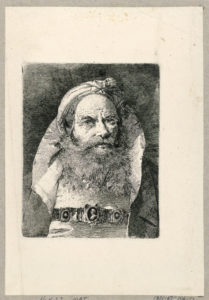Mr. Garrick in the Character of Richard III
William Hogarth
Below the image, click play to listen.
From the Riley Collection of Works on Paper
Benjamin West, P.R.A.
Below the image, click play to listen.
You can learn more about the entire series by West and M&G’s significant collection from the series HERE.
In 1780 King George III commissioned Benjamin West to create a series of paintings for his new Chapel at Windsor Castle. It’s estimated that he completed 18 of the proposed 35 paintings planned for the chapel, and M&G has the largest set of existing works from the series. To learn more click HERE.
This intriguing 18th-century painting provides a valuable reminder for all of us to consider our choices in light of a coming eternity.
This tender, graceful work by Benjamin West is one of a special series of paintings commissioned by King George III to decorate a chapel at Windsor Castle.
Visit HERE for the next video to think on things that are Worthy of Praise.
Oil on canvas
Venetian, 1696–1770
One of the latest Italian painters represented in the Museum & Gallery Collection is the greatest artist of 18th-century Venice, Giambattista Tiepolo. While Tiepolo achieved most of his fame through breathtakingly airy frescoes on the ceilings of palaces, churches, and villas, he also revived age-old themes from the Bible and antiquity through fresh interpretations. Such is the case with a series of bust-length portraits of bearded old men, begun perhaps as early as the 1740s. These men in oriental garb are widely regarded as a series of ancient philosophers, but no definite case may be made for the group since most lack traditional attributes. Tiepolo was certainly influenced by Rembrandt’s paintings of bearded old men which may also be perceived as simple character studies.
 The present painting is the original treatment by Tiepolo that together with others from the series was later copied by his artist sons, Domenico and Lorenzo, in etchings called La Raccolta de Teste (The Collection of Heads). The vigorous brushwork, vibrant colors, elaborate dress, and penetrating gaze of the sitter combine to make M&G’s Philosopher Holding a Book an excellent example of Tiepolo’s lesser-known skills at small-scale work. The etching to the left is made by Giovanni’s son as a copy of his father’s work. These smaller versions usually omit the hands, but the cloak clasp is included.
The present painting is the original treatment by Tiepolo that together with others from the series was later copied by his artist sons, Domenico and Lorenzo, in etchings called La Raccolta de Teste (The Collection of Heads). The vigorous brushwork, vibrant colors, elaborate dress, and penetrating gaze of the sitter combine to make M&G’s Philosopher Holding a Book an excellent example of Tiepolo’s lesser-known skills at small-scale work. The etching to the left is made by Giovanni’s son as a copy of his father’s work. These smaller versions usually omit the hands, but the cloak clasp is included.
One of the virtues of art that John Keats extols in his poem “Ode on a Grecian Urn” is the ability of art to ask questions of the viewer. Sometimes these questions are answerable; sometimes they aren’t. But the mystery is what draws viewers to return, allowing them to absorb more of the work as well as more of the mystery.
So, what is it that makes this seemingly straightforward portrait of a man with a book so interesting and intriguing?
All of these questions can be frustrating to art historians and viewers alike. But Keats would propose that they are an indication of good art, something beautiful that attracts further examination, pondering, and appreciation without final satisfaction. Good art pulls us out of ourselves and reminds us, like Horatio, that “there are more things in heaven and earth. . . than are dreamt of in your philosophy.” Doubtless, this philosopher with a book would have agreed.
Dr. Karen Rowe Jones, M&G board member
Published 2021